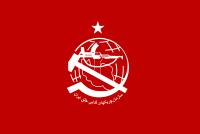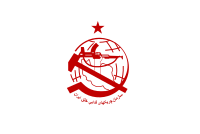Organization of Iranian People's Fedai Guerrillas سازمان چريکهای فدايی خلق ايران | |
|---|---|
 | |
| Abbreviation | OIPFG[1] |
| Spokesperson | Mehdi Fatapour[2] |
| Secretary of the Central Committee | Farrokh Negahdar[3] |
| Founded | late 1963 initial activity[4] April 1971 as the unified organization[1] |
| Dissolved | June 1980[5] |
| Merger of | Jazani-Ẓarifi Group and Aḥmadzāda-Puyān-Meftāḥi Group[1] |
| Succeeded by | OIPF (M) OIPFG (M) IPFG |
| Headquarters | Tehran |
| Newspaper | Kar[5] |
| Ideology | Communism Marxism–Leninism Anti-revisionism Anti-imperialism |
| Political position | Far-left[6] |
| Colors | Red |
| Anthem | Aftabkaran-e-Jangal (lit. 'Sunplanters of Jungle')[7] |
| Party flag | |
  | |
| Leaders | Hamid Ashraf (KIA) Ashraf Dehghani (POW) |
|---|---|
| Dates of operation | 1971–1976[8] 1977[9]–1980 |
| Group(s) | Urban team, rural team[4] |
| Size | 3,000 (estimate)[6] |
| Allies | |
| Opponents | |
| Battles and wars | Siahkal incident |
The Organization of Iranian People's Fedai Guerrillas (OIPFG; Persian: سازمان چريکهای فدايی خلق ايران, romanized: Sâzmân-e Čerik-hâye Fadâyi-e Xalğ-e Irân), simply known as Fadaiyan-e-Khalq (Persian: فداییان خلق, romanized: Fadâ'iān-e Xalğ, lit. 'Popular Self-sacrificers')[9] was an underground Marxist–Leninist guerrilla organization in Iran.[1]
The OIPFG was one of the most important and influential armed groups during the Iranian Revolution, although this organization failed to achieve its goal and lost many of its members, it had a great impact on some radical Iranian intellectuals of its generation. After its formation, the loyalists were able to carry out several important and noisy operations and assassinations, such as the Siahkal incident, the explosion of electricity pylons, the explosion of some police stations, the assassination of Major General Farsiu, the assassination of Mohammad Sadeq Fateh Yazdi, one of the largest factories in Iran, attacking and robbing government banks, and bombing the offices of American oil companies.[11][12][13][14]
- ^ a b c d Vahabzadeh, Peyman (28 March 2016) [7 December 2015]. "FADĀʾIĀN-E ḴALQ". In Yarshater, Ehsan (ed.). Encyclopædia Iranica. Bibliotheca Persica Press. Retrieved 1 August 2016.
- ^ Vahabzadeh, Peyman (2010). Guerrilla Odyssey: Modernization, Secularism, Democracy, and the Fadai Period of National Liberation In Iran, 1971–1979. Syracuse University Press. p. 67. ISBN 978-0-8156-5147-5.
- ^ Muhammad Kamal (1986). "Iranian Left in Political Dilemma". Pakistan Horizon. 39 (3). Karachi: Pakistan Institute of International Affairs: 39–51. JSTOR 41393782.
- ^ a b Abrahamian, Ervand (1982). Iran Between Two Revolutions. Princeton University Press. pp. 483–9. ISBN 0-691-10134-5.
- ^ a b Cite error: The named reference
Iranica2was invoked but never defined (see the help page). - ^ a b Donald Newton Wilber (2014). Iran, Past and Present: From Monarchy to Islamic Republic. Princeton University Press. p. 344. ISBN 978-1-4008-5747-0.
- ^ Annabelle Sreberny; Massoumeh Torfeh (2013), Cultural Revolution in Iran: Contemporary Popular Culture in the Islamic Republic, I.B. Tauris, p. 156, ISBN 978-1-78076-089-6
- ^ Cite error: The named reference
MTDwas invoked but never defined (see the help page). - ^ a b Hiro, Dilip (2013). "Fedai Khalq". A Comprehensive Dictionary of the Middle East. Interlink Publishing. pp. 483–9. ISBN 978-1-62371-033-0.
- ^ a b c Arie Perliger; William L. Eubank (2006), "Terrorism in Iran and Afghanistan: The Seeds of the Global Jihad", Middle Eastern Terrorism, Infobase Publishing, pp. 41–42, ISBN 978-1-4381-0719-6
- ^ مازیار بهروز، شورشیان آرمانخواه، ترجمه مهدی پرتوی، انتشارات ققنوس، صفحه ۱۲۱–۱۲۲.
- ^ چریکها وارداتی نبودند، مازیار بهروز، مهرنامه، شماره ۴۱، اردیبهشت ۹۴، صفحه ۱۸۷–۱۸۶.
- ^ www.niknami.ir, Tohid Niknami (+98) 9125061396. "چریکهای فدایی رها از اکثریت و اقلیت!-مؤسسه مطالعات و پژوهشهای سیاسی". psri.ir. Retrieved 16 February 2023.
{{cite web}}: CS1 maint: numeric names: authors list (link) - ^ "سیاهکل: "شکستی که حماسه شد"". BBC News فارسی (in Persian). 4 February 2011. Retrieved 15 November 2021.